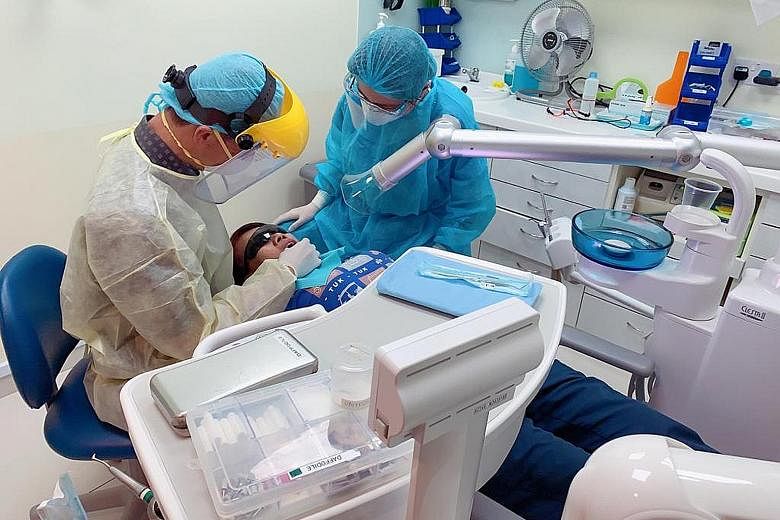Dentists have been allowed to perform all dental procedures on their patients since the start of phase two of Singapore's reopening three weeks ago.
However, because of the safety measures in place and urgent cases being prioritised, dentists are seeing only around 60 per cent of their usual number of patients.
All dental clinics and registered dental practitioners were informed by the Ministry of Health (MOH) that previously deferred dental services are allowed to resume, with priority given to urgent and emergency dental care, followed by ongoing care previously postponed.
In addition, "cases with medically indicated complaints should be prioritised over aesthetic cases", said an MOH circular dated June 17.
However, all dental treatments must continue to minimise aerosol generating procedures as these generally present a higher risk of viral transmission.
To prevent cross-infection between patients and to allow sufficient time for disinfection of all areas, appointments that require aerosol generating procedures had a 45-minute interval time between patients.
This also ensured enough time for "rooms to be rested to mitigate risk of aerosol transmission".
For all other appointments, a 15-minute interval between patients is required.
In phase two, the 45-minute interval was lifted, though many clinics still adhere to this guideline as a safety precaution.
With these guidelines in place, many dentists are seeing fewer patients - only 60 per cent to 70 per cent of the numbers before the Covid-19 outbreak.
Dr Kelvin Chye, chief operating officer of the Family Dental Centre dental group, said these restrictions have limited the number of people dentists are able to treat. He said most of the patients are follow-up cases for dentures, orthodontics and root canal treatments.
He added that a small number of patients has deferred non-essential treatments, such as routine check-ups, scaling and polishing, to later this year.
In addition to the precautionary measures, Dr Chye also ensures that all his patients use a mouth rinse containing 1 per cent povidone iodine, which he said has been proven effective in killing the Sars-Cov-2 virus in 30 seconds.
"Asymptomatic carriers of the Sars-Cov-2 virus may be present in the dental clinics. Dental treatments could potentially aerosolise the virus-loaded saliva. So the pre-procedural mouth rinse can help reduce the virus load in their oral cavities and saliva, reducing the chances of transmission between the patient and the dentist, as well as cross-infection between patients," he said.
MOH stated in its circular that patients need to have a one-minute mouth rinse before any dental procedure.
Other dental groups have installed additional oral-suction units and air purifiers to remove aerosols in treatment rooms.
For instance, the Q&M Dental Group has installed in all its treatment rooms a second aerosol suction machine, which is able to filter and clean large emissions of aerosols.
Its chief operating officer, Dr Raymond Ang, said that common treatments, such as scaling, polishing and fillings, would require the use of hand drills and scalers, which generate aerosols.
The aerosol suction machine could help to better disinfect all treatment rooms.
Dr Ang said that many patients who needed urgent dental work during the circuit breaker period have returned to complete their course of treatment.
"There is pent-up demand for dental services built up over the circuit breaker period, some of which was due to patients receiving temporary treatments," said Dr Ang.
However, patients who require regular dental check-ups are typically able to get an appointment within a week.
Housewife Aileen Chia, 30, was one of the first patients to book an appointment with Q&M on June 4, after cracking a tooth during the circuit breaker period.
As dentists were not able to provide crowning treatments then, she was given painkillers and told to avoid the painful region when chewing.
"For two weeks, it was just very frustrating and uncomfortable, especially at night, when I felt pain in the nerves of my tooth, so I was more than relieved when I was able to receive treatment for this when the circuit breaker ended," she said.
Dr Cheng Eng Wah, founder of dental chain iDental Clinics, said that more than 90 per cent of his patients are follow-up cases that require adjustments to their braces and a review of their teeth alignment.
During the circuit breaker, only patients who were in pain and discomfort, such as when the metal wire from dental braces cut the inside of the cheek, were allowed to be treated.
Dr Cheng said that many dentists have extended their working hours to clear the backlog of cases.
Although he sees about 15 patients daily, the number of new customers has fallen significantly as braces are fitted mostly for aesthetic reasons.
Dr Tan Peng Hui, 55, a dentist who specialises in root canal treatment, sees only two patients a day and makes sure he completes the full course of treatment during the visit.
Previously, he used to see about five patients daily.
"In the past, the treatments were completed over two visits, but we are trying to minimise the number of visits for each patient," said Dr Tan of Roots! Advanced Endodontics at Novena Medical Centre.
One of his patients, student Brooke McConaghy, 19, did not mind that her treatment for a root canal infection was postponed until phase one, as she had only mild symptoms such as tooth discolouration and slight pain.
Her mother, Mrs Lori McConaghy, said: "My daughter was not in a lot of pain, so she was fine with waiting until the circuit breaker lifted.
"I believe if she were (in pain), she would have been able to get treatment, as I feel Singapore is doing a great job in keeping us safe while ensuring that medical help is available if there is an emergency."
Correction note: An earlier version of the report suggested that the 45-minute interval requirement was still in place in phase two. It has since been lifted but many clinics still adhere to it. We are sorry for the error.


